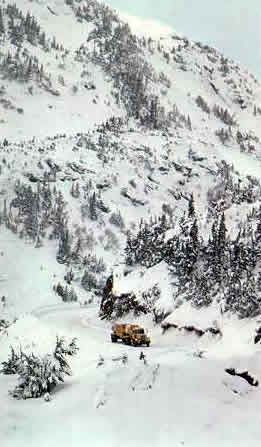
MILLING-CONTINUED
Concentrate Storage
The concentrate left the dryer via a three-conveyor system over weighing apparatus and then to the storage area. The first conveyor, from the dryer, was short, about 18 ft. long, thence to the transfer conveyor, 144 feet long and fire- resistant (the concentrate is at 135°F) and to the concentrate- storage conveyor, 159 feet long, which distributed the load over the storage area by a Hewitt-Robins travelling tripper.
The storage area was a rectangular concrete box, 28 ft. wide and 160 ft. long with a live capacity of some 9000 tons.
About 25 tons of dry copper concentrate forms a truckload for the 32-mile haul to the marine terminal at Stewart. On the return trip, the trucks carry fuel oil for the power and heating plants at the concentrator. Despite heavy snows, this road must stay open year-round.Reclamation of the stored concentrate was by a 3-drum slusher hoist and scraper. Scraper travel was about 230 feet and slusher operation was from a control room on the north side of the bay and directly alongside the discharge point.
Reclaimed concentrate falls through a grizzly into a 25- ton hopper which was partially mounted on two Asea TGPH- 10 load cells. Reclaim and load-out functions were handled by one operator in the control room.
Concentrate Haulage
Trucks being used on the 60-mile round-trip-concentrate haulage to the storage and shipping facility at Stewart are Kenworth double-unit L W 924's, hauling 25-ton Columbia semi-trailer units. There are three compartments in the trailer units -a side-dump centre section holding about 25 tons of concentrate and two end tanks used to backhaul fuel oil and other commodities for the mill operation. It took about four hours to make the round trip and at the maximum- design rate of 600 tons of concentrate per day would require 24 such round trips each day. Fuel oil demands at the property were about 170 tons per day.
